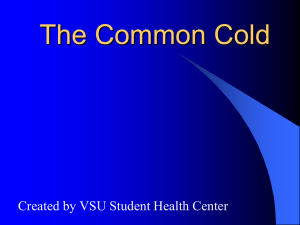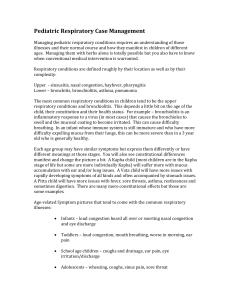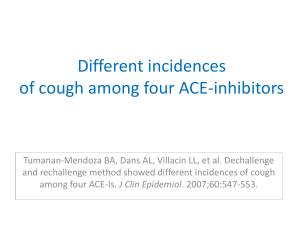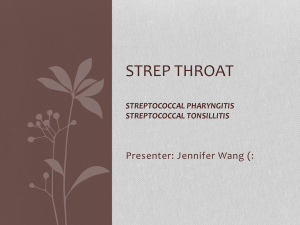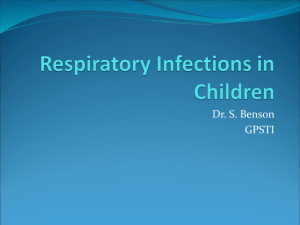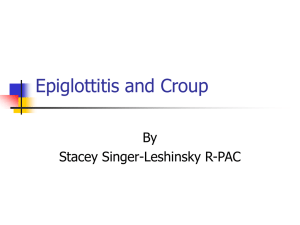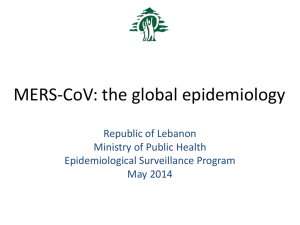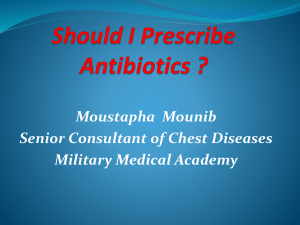Symptoms
advertisement
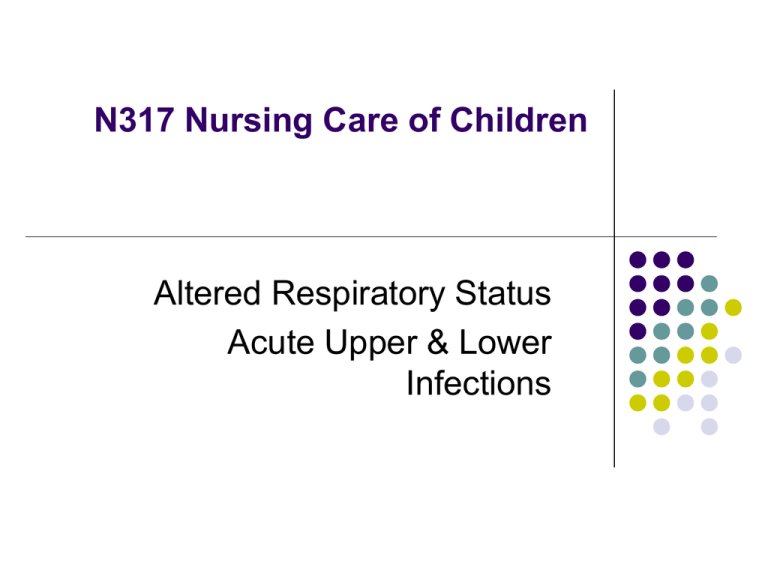
N317 Nursing Care of Children Altered Respiratory Status Acute Upper & Lower Infections General Principles URI caused by viruses Rhinovirus, RSV Most Common Bacteria B-Hemolytic Strep Staph. Aureus H. Influenza Pneumococcus General Principles Type of Organism “Dose” or amt. Of Exposure Age of Child--Young children—>Sicker Child’s Immune System Seasonal variations RSVDec.Mar., Peak in February Nasopharyngitis “Common Cold” Etiology Viral-Rhinovirus S/S Tx Dry, hacking cough ↑nasal discharge (mucous) ↓appetite & activity Sneezing, chills, irritability Supportive – no ASA Rest, Fluids Self limiting 4-10 days Do NOT give expectorants or cough meds to infants and young children due to risk of S.E. Complications: O.M. S/S Pharyngitis “Sore Throat” Viral Bacterial Cause Virus Onset Gradual Group-A ß-hemolytic Strep (GABHS) Sudden Fever Low grade Over 100° Throat Red – slight to no exudate Cough, hoarse Cherry –red, white exudates H/A, abd. Pain, enlarged lymph nodes Symptoms Management of Strep Throat MUST get throat culture or Rapid Strep Screen to make Dx Usual drug of choice: Penicillin---10 days IF ALLERGIC TO PENICILLIN: Erythromycin, azithromycin (Zithromax), clarithromycin (Biaxin), cephalosporins PCN + Rifampin is more effective than PCN alone in carriers & those with resistant strains 24° quarantine after begin antibiotics Symptomatic Tx Teach imp. of taking all antibiotics & to get new toothbrush after 24° on meds Risk for: rheumatic fever, acute glomerulonephritis Otitis Media Common causative agents—Strep pneumoniae, H. influenzae Patho / Etiology Short-wide eustachian tubes which allows for bacteria to be swept into them when tube opens; also more horizontal so don’t allow for drainage easily. Increased Lymphoid tissue Pooling of fluids (milk from bottle) in pharynx At risk: cleft palate, Down syndrome, day care, propping bottle, living with smoker(s) Peak age: 6-36 mons; winter Otitis Media S/S Tympanic membrane Red Bulging → Obstructed Light reflex No visible bony landmarks Earache Temp---1040 F common Swollen Glands Cold Sx Crying/irritable when supine Eardrum may Rupture → Decrease in pain Increase in ear drainage (on pillow) Management of Otitis Media AntibioticsP.O.:Amoxicillin, Augmentin, Trimethoprim-sulfamethoxazole (Bactrim, Septra), E-mycin-sulfisoxazole (Pediazole), Azithrmycin (Zithromax), Clarithromycin (Biaxin), Cephalosporins. IM Ceftriaxone (Rocephin) Analgesics for pain and temperature; warmth to ears; keep upright as much as possible Chronic OM: prophylactic antibiotics for 6 mos or Surgery Myringotomy to insert tympanostomy tubes Complications Hearing Loss, eardrum scarring, adhesive otitis media, chronic OM, mastoiditis Note lack of light reflex, no bony prominences, bright red, bulging appearance of tympanic membrane Acute Otitis Media Ear Tube Otitis Externa Normal ear flora becomes pathogenic in excessive wet/dry conditions (trauma or “swimmer’s ear”) Pain, edema so can’t visualize TM, hearing loss, cheesy green-blue-gray discharge Tx: antibiotic drops, 3-4x/day til pain & swelling gone, then more days Prevention: 50:50 sol. of ETOH/white vinegar gtts after swim or bath; 5” each ear Nothing in ear smaller than “elbow” Limit stay in water & dry ears after (with towel) Tonsillitis Lymphoid tissue located in pharyngeal cavity becomes infected by viral or bacterial agent Symptoms Palatine tonsils edematous (3-4+) – blocks food/air Adenoids (pharyngeal tonsils) block air from nose to throat Obstructed nasal breathing → bad breath from mouth breathing & nasal voice Persistent cough May block eustachian tubes→OM Usually self limiting if viral – must do throat culture Resource with drawings on Tonsils & Adenoids http://www.entnet.org/healthinfo/throat/tonsils.cfm tonsillitis Hypertropic tonsils T&A Surgery if documented frequent strep throats Tonsillectomy not done until after age 3 or 4 Adenoids can be removed if < 3yrs if obstructed nasal breathing Pre-op H&P, CBC, Bleeding Time, check for any loose teeth Post-op #1 priority---Assess for Bleeding – watch for excessive swallowing!! Pain Relief Hydration No milk products or anything red Discharge Instructions No Spicy foods Avoid Gargles, vigorous brushing Check for bleeding – up to 10 days post op Foul breath odor, earache, Temp.↑ Infectious Mononucleosis Def: acute, self-limiting infectious disease, common under age 25. Increase of mononuclear elements of the blood Etiology: • Epstein Barr Virus(EBV) - direct transmission with oral secretions • Incubation: 4-6 weeks after exposure Symptoms: Fatigue may last 1-2 mos malaise, sore throat, fever, HA, lymphadenopathy, spleenomegaly, rash, exudative pharyngitis Infectious Mononucleosis Diagnosis: 1. Self reported symptoms 2. Monospot (EBV antigen test); WBC - atypical lymphocytes 3. Heterophil antibody test (mono titer-1:160 is diagnostic) Management: 1. Mild analgesia; antipyretics 2. Bed rest; fluid intake 3. Enlarged spleen - no contact activities 4. Penicillin - if Strep. B is cultured from pharynx; NO ampicillin Prognosis: Self-limiting Avoid contact with live virus vaccines for several months after recovery!!! Depressed cellular immune reactivity. Croup Syndromes (middle airways infections) Symptom complex: hoarseness a resonant “barky” cough varying degrees of inspiratory stridor respiratory distress resulting from swelling/obstruction in the region of the larynx. Acute Epiglottitis Def: inflammation and swelling of the epiglottis. Etiology/Pathophysiology: ages 2-8. Haemophilus influenza most common Epiglottis become cherry red, swollen, causing obstruction of airway, secretions pool in the larynx and pharynx, complete obstruction within 2 to 6 hours. Froglike croak on inspiration Sudden onset; medical emergency Acute Epiglottitis Assessment: Sudden onset high fever & extreme sore throat The 4 D’s: dysphonia, dysphagia, drooling, distress Anxious, restless, tripod position. Inspiratory stridor, tongue protrusion Contraindication: exam of throat unless incubation equipment & personnel are available **could result in spasm & complete obstruction of airway. Acute Epiglottitis Assessment cont.: Lateral neck x-ray Never leave child unattended or without intubation equipment near Usually intubated for 24 hours; restraints may be necessary Always stay calm and help child and parent stay comfortable and calm TX: antibiotics 7-10 days; antipyretics, discharge in abt 3 days from hospital Acute Laryngotracheobronchitis (LTB) - CROUP Def: viral; inflammation, edema, narrowing of larynx, trachea, and bronchi Common in infants, toddlers; Boys>girls; most common of croup syndromes***** Causative agents: parainfluenzae virus, influenzae A and B, RSV & mycoplasma pneumoniae Inflammation/narrowing airways inspiratory stridor + suprasternal retractions Thick secretions produced + edema obstruction of airway hypoxia + CO2 accumulation resp acidosis & failure Croup: assessment and tx Assessment & Tx Onset gradual, often after URI; low-grade fever, barking cough, acute stridor, accessory muscles, retractions Pulse-OX, CXR: AP and Lat upper airways Watch for cyanosis, drooling Humidified O2, IV fluids Assist child to position of comfort; keep parents near Meds: Nebulized Racemic Epinephrine preferred over beta 2 adrenergic agonists, po corticosteroids like prednisone or Orapred Teaching: viral, worse at night & may recur for several nights, use cool mist humidifier in bedroom Seek medical help immed. if breathing is labored, child seems exhausted or very agitated, or cool air humidity tx does not improve symptoms Bronchitis (lower airways) Inflammation of the large airways; viral; usually associated with a URI, abrupt Symptoms: persistent dry, hacking, nonproductive cough; worse at night; productive by 2nd to 3rd day; low-grade fever Mild self-limiting; 5-10 days Symptomatic tx: analgesics, fluids, rest & humidity; cough suppressants only if can’t rest d/t cough Respiratory Syncytial Virus (bronchiolitis~ lower airway, cont’d) Viral - produces serious lower respiratory infections, esp. pneumonia or bronchiolitis Young children/infants (2-24 mo) 1-6 months highest risk; 50% will be infected Older children: rhinorrhea, sore throat, cold Close contact: aerosols from coughing or sneezing; also contaminated objects. Not airborne – contact isolation Incubation: 4 to 8 days Viral shedding: ~ 2 weeks RSV – Assessment Begins w/simple URI; fever (102°); can progress to severe Respiratory Distress quickly Thick nasal secretions, wheezing, fine rales; cough, anorexia, retractions, nasal flaring in infants Severe: tachypnea, dyspnea, hypoxia, cyanosis, can progress to apnea Assessment: lung auscultation, oximetry RSV swab/washings (nasopharynx, throat)—positive result CXR: overinflation, thickening, infiltrates CBC w/differential: viral shift usually present Arterial blood gases—only in severe cases Respiratory acidosis RSV: Treatment Droplet and Contact Isolation is critical: with gown, glove, mask, when holding infant Cool oxygenated mist, hydration, rest, suctioning, careful monitoring of SaO2 Respiratory Treatments via Nebulizer beta adrenergic agonists~Albuteral, Xopenex, racemic epinephrine--AAP does NOT recommend these anymore. Relieve bronchospams; EBP does not support efficacy Corticosteroids—may be given as anti-inflammatory Riboviran—Nebulizer anti viral agent; precautions Respigam—IV Immunoglobulin requires 1:1 RN Synagis—(palivizumab) RSV “Vaccine” Costly, but very worthwhile to high-risk infants IM/Monthly during high season Indicated for preemies + hx of RDS, CHD Pneumonia Inflammation of Lung Parenchyma Bronchioles; alveolar spaces Causes (can be 1° or 2°) Viral (RSV) Bacteria Pneumoncocci Staph aureus / Strep Chlamydia Primary atypical (community acquired) Mycoplasma S. pneumoniae Assessment and Diagnosis of Pneumonia Viral Etiology Mild fever, slight cough & malaise OR High fever, severe cough, & resp. distress (RSV) Unproductive cough Rhinitis Breath sounds~ few wheezes, fine crackles X-ray~diffuse, patchy infiltration R/o bacterial or mycoplasma (CBC, bld cultures, microbiology Bacterial Etiology High fever & tachypnea Bacteria in bloodstream travel to lungs and ↑ there Cough~unproductive→productive w/white sputum; exhausting Breath sounds~rhonchi or crackles Retractions, chest pain, nasal flaring Pallor-cyanosis X-ray~diffuse or patchy infiltration; ↑fluid as alveoli fill w/fluid & exudates May involve 1 segment or entire lung Behavior~ irritable, restless, lethargic GI~ anorexia, V&D, abdominal pain WBC (neutrophils) ASO titer if Strep Treatment of Pnemonia Viral Supportive care: antipyretics & hydration Self limiting Monitor lung sounds, VS, respiratory status of patient; oximetry; bld gases Humidification; O2 prn Chest physiotherapy Antibiotics are not indicated unless for prophylactic use Teach parents s/s of dehydration & ↑ resp distress Bacterial Antibiotics are indicated Outpatient~ may use po Amoxicillin clavulanate (Augmentin) or 2nd generation cephalosporin Hospitalized pt~ parenteral antibiotic therapy with Ampicillin sulbactam(Unasyn) and cefuroxime All interventions for viral etiology are also implemented here May need to splint chest d/t cough Primary Atypical Pneumonia Etiology: mycoplasma pneumoniae, fall/winter; crowded living conditions. Peak ages 5-12yrs. Symptoms: sudden/insidious onset. Fever, HA, malaise, anorexia, myalgia, rhinitis, sore throat, cough; fine crackles over lung fields. May last up to 2 wks. Management: Most recover in 7-10days with symptomatic treatment. Hospitalization not usually necessary. Erythromycin drug of choice.

